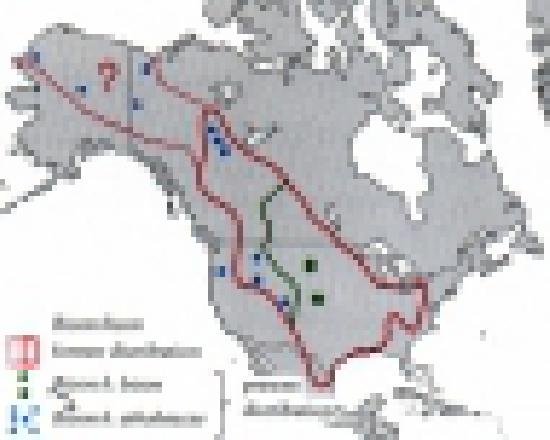English: American Bison; French: Bison americain; Chipewyan: Jejëre Junarejëre; Cree: Puscowmostus; Dogrip: Jehji; South Slavey: dechitah goejide; Spanish: Bisonte.
Former distribution: Across North America from Alaska south to the open plains of Sonora, Mexico, and east to the coastal states of the Atlantic Ocean.
Present distribution: In parks and enclosures, throughout Canada and the United States (Yellowstone and Wood Buffalo National Parks, McKenzie Bison Sanctuary, Elk Islands). Alaska has several small free-ranging herds of plain bison (Bison b. bison), introduced in 1928. Introduced into Spain, USSR.
Behaviour: See Wisent. Preferred habitat: predominantly open prairie. They are grazing animals. Seasonal movements usual. Predators wolves.
Population status: Stable again. Before the arrival of European settlers there were appr. 30 million Bison, by 1889 reduced to 541. Populations are now increasing.
Brief notes:
Body weight: 800-1000 kg
Head and body length: 250-380 cm
Tail length: 60-90 cm
Shoulder height: 175-195 cm
Gestation period: 270-300 days
Maximum age: Up to 20 years
Trophy: Record SCI: 77 7/8 score, 1981 USA, S.D. GERALD P. BEGNAUD jr.; average 54 score. B&C: 136 4/8 score, 1925 USA, Wyoming, S. WOODRING; average 155 score.
Hunting methods: Stalking and on horseback.
Subspecies: 2
1. Plain Bison Bison b. bison From central Canada throughout the USA. Stable. Estimated numbers: 80 000. Introduced into Alaska.
2. Wood Bison Bison b. athabascae West and north of the range of Bison b. bonasus to Alaska. Stable. Estimated numbers: No records.
Remarks: The slaughter of the bison population by human settlers from 30 millions down to 500 in a period of a few decades, is one of the most humiliating periods in the history of man and cannot be excused. There is no example of such wholesale slaughter anywhere in the world. These settlers were not hunters – they had political motives to kill the bison in order to limit the indigenous Indian population who were dependent on this animal. Fortunately the existing bison populations – mostly fenced in or in parks – are increasing due to trophy hunting and meat production. But the fascinating habits and culture of the Indians were destroyed for all time. Today, a new beef cattle has been deve loped, the „Beefalo“. About 2 million (beef cattle of these new race) are now bred in USA. More and more farmers prefer pure-bred Bison or „Beefalos“ for farming instead of real beef cattle.
